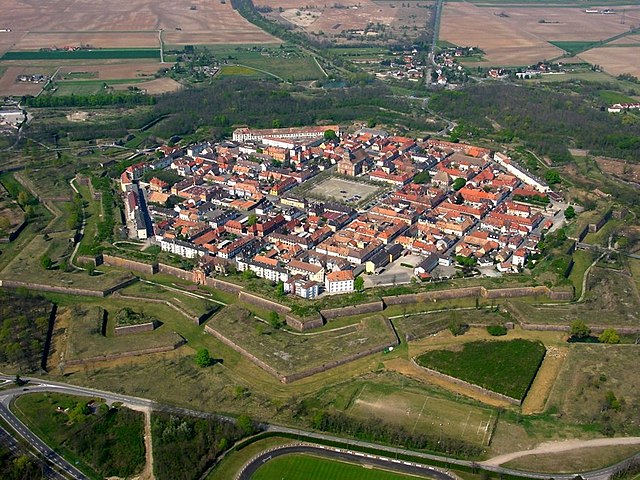Loading AI tools
Outward structure of a fortification From Wikipedia, the free encyclopedia
A bastion is a structure projecting outward from the curtain wall of a fortification,[1] most commonly angular in shape and positioned at the corners of the fort. The fully developed bastion consists of two faces and two flanks, with fire from the flanks being able to protect the curtain wall and the adjacent bastions.[2] Compared with the medieval fortified towers they replaced, bastion fortifications offered a greater degree of passive resistance and more scope for ranged defence in the age of gunpowder artillery. As military architecture, the bastion is one element in the style of fortification dominant from the mid 16th to mid 19th centuries.


By the middle of the 15th century, artillery pieces had become powerful enough to make the traditional medieval round tower and curtain wall obsolete. This was exemplified by the campaigns of Charles VII of France who reduced the towns and castles held by the English during the latter stages of the Hundred Years War, and by the fall of Constantinople in 1453 to the large cannon of the Turkish army.[3]
During the Eighty Years War (1568–1648) Dutch military engineers developed the concepts further by lengthening the faces and shortening the curtain walls of the bastions. The resulting construction was called a bolwerk. To augment this change they placed v-shaped outworks known as ravelins in front of the bastions and curtain walls to protect them from direct artillery fire.[3]
These ideas were further developed and incorporated into the trace italienne forts by Sébastien Le Prestre de Vauban,[3] that remained in use during the Napoleonic Wars.

Bastions differ from medieval towers in a number of respects. Bastions are lower than towers and are normally of similar height to the adjacent curtain wall. The height of towers, although making them difficult to scale, also made them easy for artillery to destroy. A bastion would normally have a ditch in front, the opposite side of which would be built up above the natural level then slope away gradually. This glacis shielded most of the bastion from the attacker's cannon while the distance from the base of the ditch to the top of the bastion meant it was still difficult to scale.

In contrast to typical late medieval towers, bastions (apart from early examples) were flat sided rather than curved. This eliminated dead ground making it possible for the defenders to fire upon any point directly in front of the bastion.
Bastions also cover a larger area than most towers. This allows more cannons to be mounted and provided enough space for the crews to operate them.
Surviving examples of bastions are usually faced with masonry. Unlike the wall of a tower this was just a retaining wall; cannonballs were expected to pass through this and be absorbed by a greater thickness of hard-packed earth or rubble behind. The top of the bastion was exposed to enemy fire, and normally would not be faced with masonry as cannonballs hitting the surface would scatter lethal stone shards among the defenders.
If a bastion was successfully stormed, it could provide the attackers with a stronghold from which to launch further attacks. Some bastion designs attempted to minimise this problem.[4] This could be achieved by the use of retrenchments in which a trench was dug across the rear (gorge) of the bastion, isolating it from the main rampart.[5]

Various kinds of bastions have been used throughout history:
Seamless Wikipedia browsing. On steroids.
Every time you click a link to Wikipedia, Wiktionary or Wikiquote in your browser's search results, it will show the modern Wikiwand interface.
Wikiwand extension is a five stars, simple, with minimum permission required to keep your browsing private, safe and transparent.